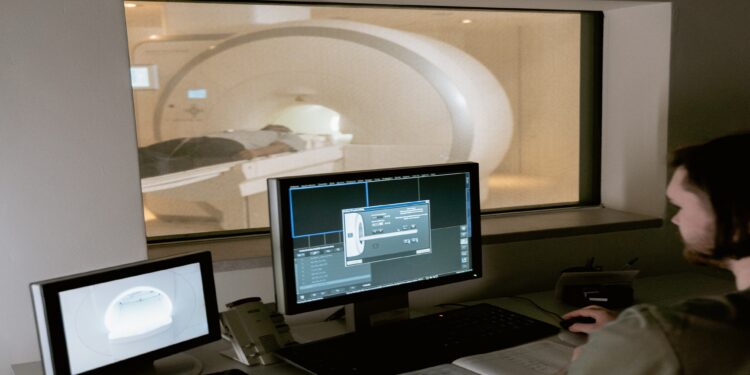
X-ray Image Production Equipment Operation
Radiology, as a specialty, is incredibly dependent on technology. As a result, radiologists and technologists need to understand the technology and the physical principles that create the advantages, limitations, and risks of the equipment used in practice. Understanding these principles provides an ability to improve image quality and select the most appropriate way to create a radiograph. A radiograph is the oldest and one of the most common modalities.[1] The general radiographic room contains a few basic components to produce X-ray beams: tube, tube housing, generator, beam filtration system, and collimator.
The X-ray tube is the source of the X-ray beam. The basic components of the X-ray tube include a cathode, anode, rotor, envelope, tube port, cable sockets, and tube housing. The generator allows the radiology technologist to control three-technique factors: tube voltage applied across the X-ray tube, the tube current that flows through the X-ray tube, and the total exposure time during which the current flows.
The cathode is the source of electrons. It is the negative electrode in an X-ray tube and, most commonly, made of a tungsten filament. The size of the filament used depends on the technique factors. When energy is applied, the filament heats up; electrons build at the cathode, and, through a process called thermionic emission, these electrons are then released from the filament surface. The rate of electron release is determined by the current applied and the temperature of the filament. Electrons accelerate toward the positively charged anode.[2] The anode is where electrons decelerate, and the energy from deceleration is released in the form of heat and X-rays (photons). The X-ray tube’s output is emission-limited, and the filament current dictates the X-ray tube current. The tube current is proportional to the x-ray flux at any tube voltage applied. The emitted electrons are focused into a concentrated group accelerated toward the anode, striking a small area called the focal spot. The filament length and electron distribution determine the focal spot’s size.
The positively charged anode is the target of electrons released from the cathode. Most of the electrons that strike the anode deposit their kinetic energy, generated by the applied tube voltage and current, as heat. Only a small fraction go on to produce X-rays. As a result, a significant amount of heat is generated at the anode in the production of diagnostic images. Stationary anodes were used in the past. However, the small focal spot on a stationary anode limits the number of X-rays that can be produced without damaging the anode. Therefore, most X-ray machines today use a rotating anode. This allows for the spread of heat over a larger area, which allows for greater tube currents and exposure durations. The rotating anode is a disk mounted on a bearing supported rotor assembly. The rotor consists of a center iron cylinder with surrounding copper bars. The stator device is made of electromagnets that surround the rotor. When an alternating current passes through the electromagnets of the stator, it produces a rotating magnetic field. This field produces an electrical current in the rotor’s copper bars, which, in turn, creates an opposing magnetic field to the one induced by the stator—the results in the rotation of the rotor device. Rotation speeds of up to 10,000 revolutions per minute can be produced.
The cathode, anode, rotor apparatus, and the other associated structures are collectively called the X-ray tube insert. They are all contained in a glass or metal enclosure and sealed under a high vacuum. This enclosure is known as the envelope. X-ray photons emitted from the focal spot scatter in all directions. The use of a tube port helps form a useful beam.
The X-ray tube housing provides shielding and cooling of the X-ray tube insert. Typically, between the insert and the housing is a layer of oil that provides heat conduction and electrical insulation. A lead shield is also applied to the inside of the housing to attenuate X-rays that are not directed to the tube port. However, not all X-rays are blocked, and the fraction that penetrates the housing is known as leakage radiation. Each tube housing has a maximum tube potential that should not be exceeded during operation at the risk of an unacceptable amount of leakage radiation.
The Review
Shadow Tactics: Blades of the Shogun
A wonderful serenity has taken possession of my entire soul, like these sweet mornings of spring which I enjoy with my whole heart. I am alone, and feel the charm of existence in this spot, which was created for the bliss of souls like mine.
PROS
- Good low light camera
- Water resistant
- Double the internal capacity
CONS
- Lacks clear upgrades
- Same design used for last three phones
- Battery life unimpressive
Review Breakdown
-
Design
-
Performance
-
Camera
-
Battery
-
Price



















